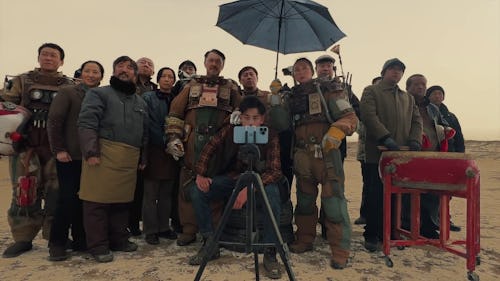
Advertising works. Good ads — print, or digital, or TV, or experiential marketing, or whatever — don’t just try to sell you a product. They sell a feeling, be it desire or inspiration.
There’s a reason iconic ads like Ridley Scott’s “1984” or TBWA\Chiat\Day’s “Think Different” for Apple or Budweiser’s “Wassup” TV spots are repeatedly referenced today. They bottle the zeitgeist and evoked (and continue to evoke) a certain vibe.
Every year since 2018, Apple has released a Chinese New Year film shot with its latest iPhone 13 Pro. The first one, “Three Minutes” directed by Peter Chan was 7 minutes and 7 seconds. This year’s short film, “The Comeback” directed by Zhang Meng is the longest one yet at 23 minutes and 15 seconds.
As ads, these short films, made to coincide with Chinese New Year, exist to sell people iPhones. Here’s what the new iPhone camera is capable of capturing. Look at how incredible the video quality is. That these are ads with a capitalist motive is not lost on me and shouldn’t be on you.
But even though I know these are ads, the underlying tone and messaging hits different. Year after year, I’ve watched these short films — and the incredible behind-the-scenes look at the making of them — and felt something more. Yes, they sell you a new iPhone, but there’s a warmth to them that few ads for tech products truly know how to instill. Many ads (including many of Apple’s) for gadgets are cold, loud in their audio/visual presentation leaving little doubt of their intentions.
My takeaway from these Chinese New Year videos has never been “Friend, you need the new iPhone.” It has always been inspiration. Doing more with less and within the limits of an iPhone’s camera. Tech-nerd-me can easily pick out the shots where Apple is showing off the latest capabilities like stabilization and Cinematic mode. And I chuckle whenever I see the footage quality fall apart in darker low-light shots. But by the end of the video, I just want to go out and shoot my own short film.
iPhones are an incredible stepping stone into the world of filmmaking.
These spots do an excellent job at showcasing the essence of filmmaking like teamwork and being inventive with shots (i.e. taping a phone to a wheel to get a whole new point of view or creating Mars from a cooking pan). One look at the TikTok, Instagram, and YouTube revolution over the past decade and it’s clear the youths are not held back by their lack of big-budget production gear. In fact, they’re embracing these features to great effect (and business) on social media. Established YouTubers who started channels with nothing more than a camcorder or an iPod touch’s camera: Would your younger self not gush at having pro-like features that enable more than what your old cameras were capable of? iPhones are not yet (and may never be) the endgame for cameras, but there is no doubt they are an incredible stepping stone into the world of filmmaking.
People — including myself — poke fun at Apple for marketing features like ProRes, and for dragging out big-shot movie directors and/or cinematographers to show how you could literally create Hollywood-style video. And the company will point to esteemed directors like Steven Soderbergh who shot movies like High Flying Bird with an iPhone 8 (with certain accessories and mounts of course) as proof that the iPhone is cinema-grade. It’s not quite. Features like Cinematic mode on the iPhone 13 and iPhone 13 Pro are impressive, but the details are imperfect. Used subtly in certain scenes, the “rack focus” aka the transition of focus from one subject in the foreground to another in the background, can be effective for emphasis. You really have to be deliberately looking for the subtleties of the imperfect edge segmentations in, for example, the scene in “The Comeback” where the son and father are having a conversation while hunkering down in a van waiting for a sandstorm to pass.
That suspension of disbelief moment is the magic Apple is trying to convey about the iPhone 13’s video abilities. It’s not about a perfect replication of a DSLR or even a cinema camera. Just like Portrait mode for still photos is not a perfect replication of a portrait photo (it still struggles with segmentation around hair) taken with a nice camera and a prime lens, the aesthetic and emotion that the director behind the frame is trying to communicate still comes across.
With good technique and vision, other smartphones like the Galaxy S21 Ultra and Pixel 6 Pro are capable of shooting good videos, too. Cameras are just that good, especially in flagship phones. But where they market the merits of “pro modes” and manual settings for things like aperture or shutter speed or ISO, they falter in nailing the accessibility that Apple balances and promotes with iPhones. In filmmaking, storytelling is king, while gear and technical settings are secondary and tertiary. With phones, because of their limitations, storytelling has to be front and center to compensate for image quality and limited manual controls. It’s a forceful, but lovely way to push creativity outside of norms.
More than any previous Apple Chinese New Year spot, “The Comeback” doesn’t just promote #ShotoniPhone” but shows you how to shoot on iPhone. “The Comeback” is a film shot on iPhone about a Chinese town coming together to create a movie shot on iPhone while showing snippets of the shot-on-iPhone filmmaking process. It’s meta as hell and moved me enough to write this here blog. Hope you’re inspired like I was. Just don’t ask me how a guy from a poor Chinese town can afford an iPhone 13 Pro Max. Maybe he saved up (he did move to a city). I suppose that’s another undertone to the ad but that’s a separate topic for discussion.







